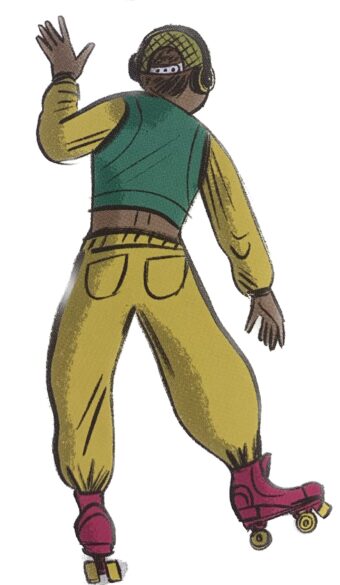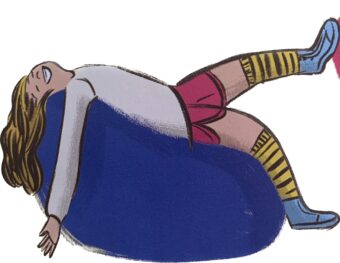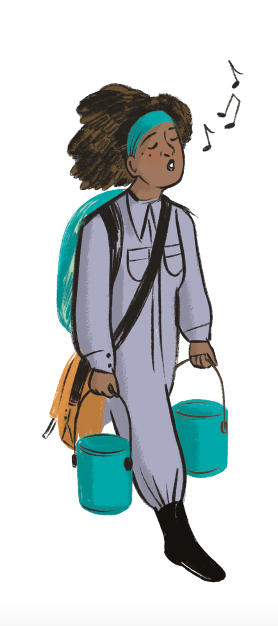Reviews of City of Neighbors

“Exuberant, creatively intertwined illustrations… A lively exposition of creative community-building projects.”
“Placemaking—shaping public spaces through community action—can make urban neighborhoods friendlier and more fun and inclusive. In her fourth book in her ThinkCities series, Canadian writer Curtis looks at ways people in cities all over the world—from Mexico City to Tokyo, Addis Ababa to Auckland—have made changes for the better. The ideas are both surprising and inspiring: brightly painted benches, open-air libraries, pianos left out for passersby to play, pop-up parks, and public bathrooms with transparent walls that become opaque when the space is occupied. The text is set against exuberant, creatively intertwined illustrations that depict city dwellers diverse in ethnicity, age, and ability. People can be seen walking, riding bicycles, making art or conversation, playing, and just chilling out. Realistically, there are occasional cars, but the focus is on the people, a true city of neighbors.… The author concludes by inviting readers to get involved, offering an extensive list of suggestions for getting started.” —Kirkus Reviews
⭐⭐⭐⭐⭐
“City of Neighbors is an outstanding narrative nonfiction book to inspire community action and galvanize positive change. Highly recommended.”
“The thought-provoking “ThinkCities” nonfiction picture book series is inspired by “the urgency for new approaches to sustainable urban life.” City of Neighbors, the latest entry…explores the magic that happens when individuals work together to create welcoming communities.
Award-winning author Andrea Curtis ponders, “What can we do together to make our neighborhoods great?” Clearly written passages define and explain the participatory process of placemaking (“When people set out to improve city spaces with creativity, inclusiveness and a sense of fun”). The well-written text references and honours Indigenous people as the original placemakers, deeply connected to their environment. Urban thinkers who championed a community-based approach to city building, like Jane Jacobs and William H. Whyte, are briefly introduced….
Like chatting with a friend, the narrative is lively and interesting. Descriptions of a fantastical playground in Toyko, Japan, sing with genuine enthusiasm: “3,000-plus recycled tires have been hauled in to build swings, bridges, climbers and two enormous Godzilla-like monsters!” Other bright ideas highlighted include the transformation of a gloomy alley in Athens, Greece, into a spectacular “light ceiling” decorated with donated old light fixtures and lampshades. At night, a public washroom in Tokyo, Japan, “lights up the park like a gleaming lantern” with see-through glass, and, when the door is locked, the windows become frosted for privacy.
Katy Dockrill’s inviting brush-and-ink illustrations show diverse communities around the world, all actively engaged in turning the place they call home into a space that’s more fun to live for everyone: kids wave from lemonade stands, families tend to community gardens, and apartment dwellers have neighborly balcony conversations. Expansive scenes fill the pages and enhance the text in a playful manner… City of Neighbors is an outstanding narrative nonfiction book to inspire community action and galvanize positive change. Highly Recommended”—Linda Ludke, Canadian Review of Materials
“Brimming with laughter and joy, City of Neighbors is sure to be a crowd-pleaser – librarians definitely included.”
“City of Neighbors, the lastest title in the ThinkCities series, celebrates city living, with a focus on urban neighbourhoods and neighbourly connections.
This illustrated nonfiction book envelops readers in the sights, tastes, smells, and sounds of cities. Toronto author Andrea Curtis points out that “neighborhoods where people know one another and spend time in shared spaces are more secure and comfortable.” In a lighthearted and inviting tone, Curtis prompts readers to “help create a city of neighbors.”
The narrative flows seamlessly, exploring ways citizens can work together to improve urban spaces and provides examples from well-known cities around the world….
The brush and ink artwork by Toronto artist Katy Dockrill has an authentic, welcoming feel that is perfect to pore over…. Brimming with laughter and joy, City of Neighbors is sure to be a crowd-pleaser – librarians definitely included.”—Jill Bryant, Quill and Quire
“Filled with suggestions and examples of what students can do to help their city neighborhood gain a sense of community…. Recommended.”
“This book is the fourth title in the ThinkCities series, which encourages urban young people to work together to make their neighborhood a happy, welcoming place and to build a sense of community. This book takes readers around the world exploring various community public spots that are as simple as benches for neighbors to sit and chat to larger parks and playgrounds for children. Each page explores another idea and example of how an unused city space was transformed into a place people wanted to gather and use. How community spirit can be enhanced with paint, music, lights, dance, and even food is suggested as ways to get involved with establishing a neighborhood haven. Along with colorful illustrations, this book is filled with suggestions and examples of what students can do to help their city neighborhood gain a sense of community. This book could promote a lot of discussion with students about their own neighborhoods and how and where they may be able to help build a spot their own community members would enjoy. Recommended.” —School Library Connection
“Future Mayors and city planners grab a copy of City of Neighbours by Andrea Curtis and Katy Dockrill and learn all about what it takes to make communities vibrant and safe.”
In reader friendly text, Andrea Curtis reminds readers of all the amazing things that are happening all over the world to make communities feel safe and to create usable, accessible spaces for all of those living and working together.
This middle grade nonfiction book reads quite like a story as opposed to just throwing information at the readers. There are no sidebars, maps or labeled diagrams which I would normally look for in a great nonfiction title but I actually loved the narrative in this book. This felt more like a community read. Each page features an informative paragraph explaining ways in which libraries, parks, sports, etc are all part of the community landscape that can create a city of neighbours. I love that I learned a new word: placemaking: when citizens set out to improve their city spaces with creativity, accessibility and a sense of fun.
I love that Andrea Curtis provides step-by–step instructions for readers to help create their own vibrant spaces in their own communities. She asks questions to help guide the reders in their own placemaking.
Katy Dockrill’s illustrations are a feast for the eyes. Each two page spread features bold and colourful illustrations that reflect how unused spaces can become joyful destinations in neighbourhoods. Her illustrations are a patchwork of people, animals and spaces with a muralesque feel making readers return over and over to find something new in the pages.
If you live in Toronto, you know in June we will be electing a new Mayor. This is the perfect book for all Mayoral candidates to read and reflect upon. It’s also a great book for young urban activists to use to question the candidates to see where they stand with placemaking.”—Storytime with Stephanie
“Readers inspired to undertake some local urban renewal of their own will find a helpful checklist and lists of resources at the end.”
“Taking a positive approach, Curtis focuses on success stories: a street in Lisbon that saw an economic revival after being painted pink, a playground in Tokyo made entirely of ingeniously repurposed tires, floating mini-docks in Izmir, Türkiye, and waterside hammocks in Halifax that have proved popular spots for hanging out. Exhorting readers to look for ways to boost their own communities from “all right to AWE-mazing,” the author suggests other types of projects, from sponsoring street art or music to creating green spaces or temporary “pop up parks.” The illustrator matches the upbeat tone of the narrative with street scenes featuring groups of residents and visitors casually lounging on, strolling past, or otherwise enjoying the results of these many types of “placemaking” initiatives. Readers inspired to undertake some local urban renewal of their own will find a helpful checklist and lists of resources at the end.”—Booklist
“Packed with ideas that young readers are encouraged to emulate in their own neighbourhoods.”
City of Neighbors “shows ideas from cities around the world, revealing how small, simple innovations have created inviting spaces providing a sense of community… this book is packed with ideas that young readers are encouraged to emulate in their own neighbourhoods…. Many suggestions might be suitable for group or classroom projects as students consider, ‘What can we do together to make our neighbourhoods great?’
The text intermingles with colourful, joyful and whimsical illustrations, representing all ages and races going about their lives in their happy, innovative neighbourhoods…”—Canadian Children’s Book News
← back to main page


